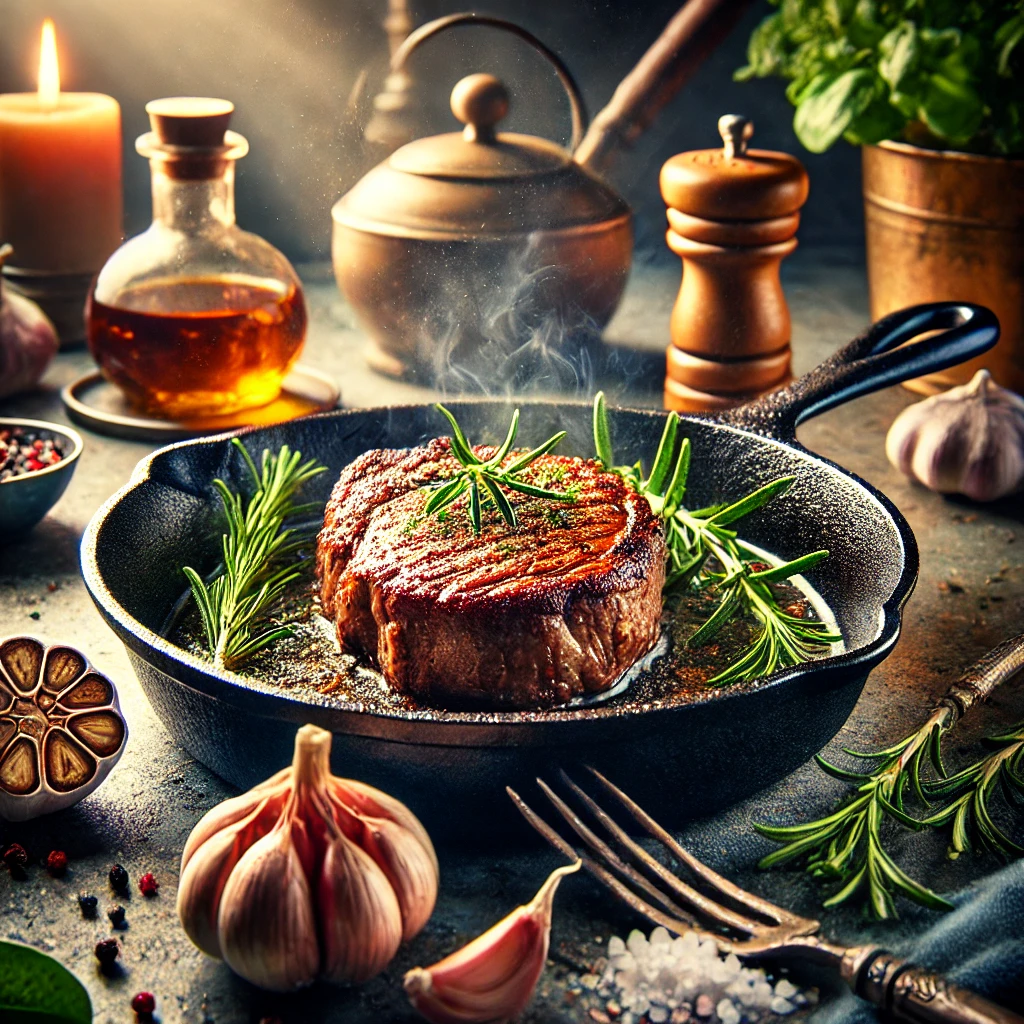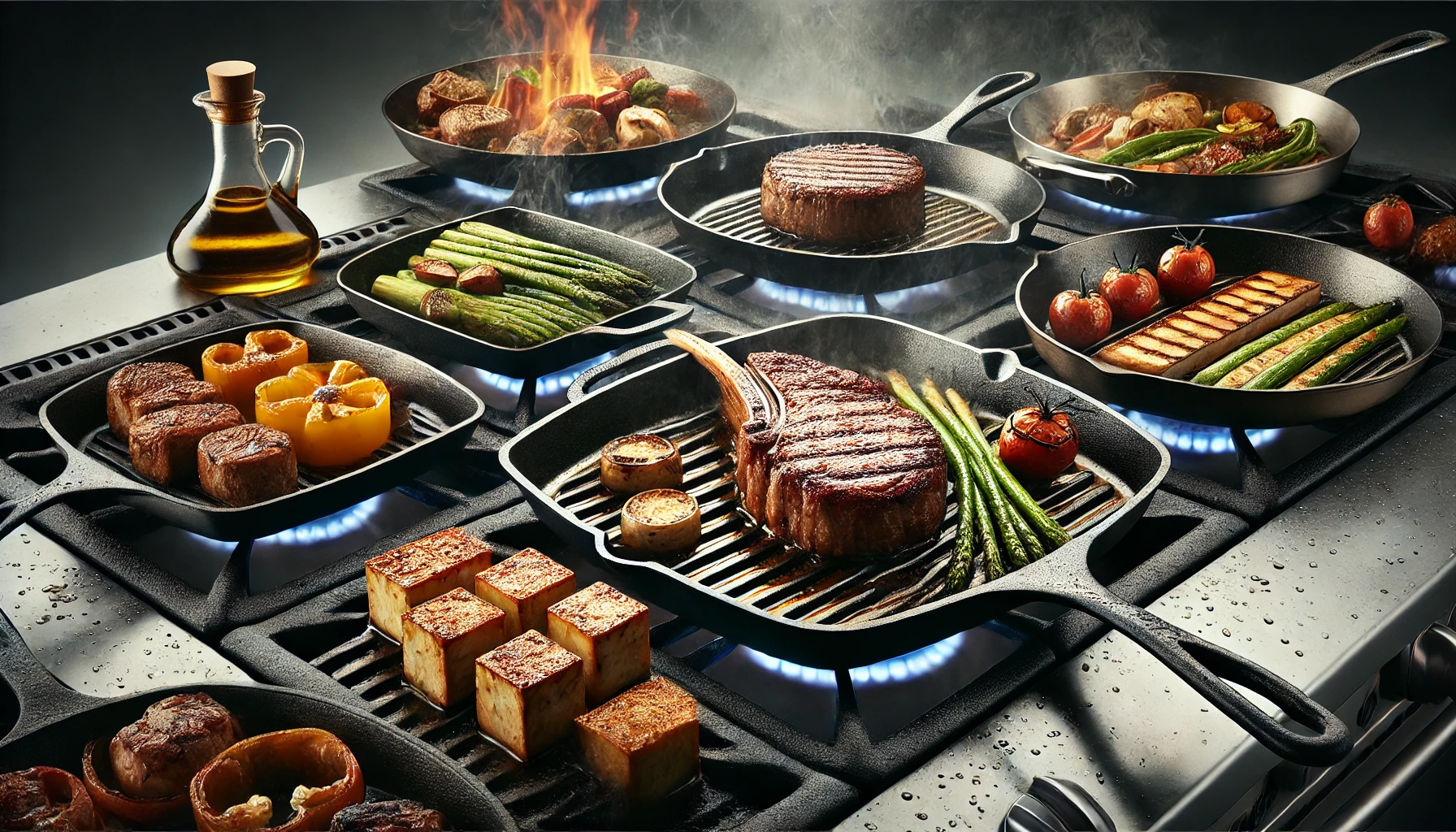The Allure of the Sizzle
There’s an undeniable magic in the moment food hits a hot pan. The smoky aroma, the satisfying sizzle, and the golden crust forming on the surface all create a sensory experience that transforms cooking into something special. This isn’t just about heat meeting ingredients; it’s the art of searing—a technique deeply rooted in science and embraced across global cuisines.
Searing is more than browning food; it’s a transformative process. This technique adds depth, aroma, and texture to the simplest ingredients, turning them into extraordinary dishes. In Korean cuisine, for instance, searing enhances classic dishes like bulgogi and grilled vegetables, adding a smoky layer that’s hard to resist. By understanding the science of searing, you can elevate your cooking and bring out bold, rich flavors. Let’s dive into this powerful technique.
The Maillard Reaction: Science Behind Searing
The Maillard Reaction, named after French chemist Louis-Camille Maillard, is essential for understanding why searing creates such complex flavors. This chemical reaction occurs when high heat causes amino acids and sugars on the surface of food to interact, forming a golden-brown crust. It’s this process that gives seared food its unique taste and aroma.
As food heats up, proteins and sugars rearrange, creating hundreds of new flavor compounds. A well-seared steak, for example, has a savory, umami-rich crust that contrasts with its juicy interior, offering a deeply satisfying bite. This reaction doesn’t just happen with meat; vegetables and tofu also develop richer flavors through the Maillard Reaction.
Korean cuisine, known for its high-heat cooking techniques, frequently uses searing. Korean barbecue is a prime example, where high heat creates a caramelized crust on beef, pork, or chicken, adding smoky and savory notes. This technique, though rooted in science, has universal appeal, enhancing dishes across culinary traditions.

Why Searing Matters: Unlocking the Flavor Potential of Every Ingredient
Searing intensifies flavors, adding a richness that’s hard to achieve with other cooking methods. At the core of this flavor enhancement is the Maillard Reaction, which brings out deep, savory notes in foods. For instance, tofu or a simple vegetable, when exposed to high heat, develops a satisfying depth and complexity.
In Korean cuisine, searing is essential for dishes like bulgogi and samgyeopsal. The high heat caramelizes the sugars in marinades, adding a smoky sweetness that perfectly balances the savory elements. This technique can transform even the simplest ingredients, giving them a universally appealing flavor and texture.
A Step-by-Step Guide to Mastering Searing
Achieving the perfect sear requires attention to three key elements: temperature, moisture control, and timing. Here’s a step-by-step guide:
- Start with High Heat: Preheat your skillet or grill on medium-high for a few minutes. When a drop of water instantly sizzles, it’s ready for searing. High heat is crucial for immediate browning.
- Choose the Right Oil: Select oils with high smoke points, like grapeseed, avocado, or vegetable oil. Olive oil burns easily at high temperatures, which can add a bitter taste. Neutral oils keep your ingredients’ flavors intact.
- Dry the Surface: Excess moisture prevents proper browning by cooling the pan and creating steam. Pat ingredients dry with a paper towel for an even, crispy surface.
- Avoid Overcrowding: Searing works best with space. Overcrowding lowers the pan’s temperature, leading to steaming rather than browning. Work in batches if necessary.
- Let It Sit: Allow food to stay still in the pan to develop a crust. For meats, this usually takes 2-3 minutes per side. If food sticks, give it more time; it should release naturally when browned.
Korean Ingredients That Benefit from Searing
Searing is versatile and can elevate a variety of Korean ingredients. From bulgogi beef to tofu and mushrooms, this technique brings out complex flavors. For instance, high heat caramelizes sugars in bulgogi marinades, adding smoky sweetness to the savory profile.
Tofu, often thought of as bland, transforms under high heat. Pressed, seasoned, and seared, it gains a crispy crust that enhances both taste and texture. Seared mushrooms, on the other hand, bring a rich umami flavor that’s perfect for dishes like bibimbap, adding a hearty texture without meat.
Searing in Korean Cuisine and Its Global Influence
Though often associated with Western cooking, searing is foundational in Korean cuisine as well. Traditional Korean dishes like galbi (갈비) and samgyeopsal (삼겹살) rely on high-heat grilling, which mirrors the principles of searing. The result is a delicious, crispy crust that enhances both flavor and texture.
In recent years, Korean cooking has embraced fusion techniques, combining searing with traditional flavors. For example, seared kimchi fried rice incorporates a smoky crust that complements the spicy kimchi. This blend of global methods with Korean ingredients creates exciting new dishes, allowing home cooks to enjoy traditional flavors with modern twists.
Globally, the appeal of searing extends to dishes like French pan-seared duck and Japanese yakitori. This universal technique enhances ingredients across cuisines, making it a valuable skill for any cook aiming to create bold, memorable dishes.
Choosing the Right Tools for Perfect Searing
A successful sear isn’t just about technique; it also depends on the right tools. For consistent heat, a heavy-bottomed pan is essential. Let’s explore the best options:
- Cast Iron Skillets: Known for excellent heat retention, cast iron pans create an even, golden crust. Their natural rough surface also helps form fond, the flavorful bits left after cooking, which are perfect for making pan sauces.
- Stainless Steel Pans: Stainless steel pans offer a smooth, even cooking surface and withstand high temperatures. They’re ideal for searing delicate proteins, like fish, where you want a crisp crust without sticking.
- Nonstick Pans: Generally not recommended for high-heat searing, nonstick pans are better suited to low- to medium-heat tasks. Nonstick surfaces don’t allow fond formation, which is crucial for rich pan sauces.
Oil choice is also critical. Use high-smoke-point oils like avocado, canola, or grapeseed oil to avoid burning and maintain a clean, natural taste. Olive oil has a lower smoke point and can impart a burnt flavor, making it less ideal for high-heat searing.
Enhancing Flavor with Seasonings, Marinades, and Fond
The magic of searing is amplified when paired with the right seasonings and marinades. Salt, for example, draws out surface moisture, helping create a dry crust. Here’s how to boost flavors even more:
- Pre-Salting (Dry Brining): For meats, sprinkle salt on the surface and let it rest for 30 minutes to an hour before cooking. This technique enhances flavor and draws out surface moisture, creating a dry crust that browns better.
- Marinades for Depth: Marinades infused with soy sauce, garlic, and sesame oil are perfect for Korean dishes. Avoid sugary marinades at the start, as sugar can burn. Instead, brush sweet glazes on during the last few minutes of cooking.
- Herb and Spice Infusion: Adding whole herbs or garlic to the pan infuses food with aromatic qualities. This works particularly well for dishes like pan-seared bulgogi.
Making Use of Fond: Crafting a Rich Pan Sauce
Fond, the golden-brown bits left after mastering the Science of Searing, is packed with flavor. Here’s how to turn it into a delicious sauce:
- Deglaze the Pan: After searing, lower the heat and add a small amount of liquid, like broth or vinegar, to dissolve the fond.
- Build Layers with Aromatics: Once deglazed, add garlic, shallots, or fresh herbs for depth. For a Korean twist, add a bit of gochujang for heat and sweetness.
- Finish the Sauce: Reduce the sauce slightly, then add a touch of butter for richness and a squeeze of lemon or rice vinegar for balance. Drizzle over seared meat or vegetables for a flavorful finish.
Searing Beyond Meat: Exploring Plant-Based Ingredients
While searing is often associated with meat, the Science of Searing also works wonders for plant-based ingredients. Vegetables, tofu, and even fruits gain new textures and flavors when seared.
- Vegetables: Ingredients like bell peppers, zucchini, and mushrooms develop a caramelized exterior, bringing out their natural sweetness. In bibimbap, seared mushrooms add umami depth and a hearty texture.
- Tofu: Tofu gains a satisfying crust when pressed and seared, contrasting beautifully with its soft interior. This method enhances tofu’s flavor, making it a delicious addition to stir-fries or rice bowls.
- Fruits: Fruits like pineapple or peaches caramelize under high heat, adding a smoky sweetness that pairs well with savory dishes, especially spicy Korean barbecue.
Practical Tips for Experimenting with Searing
Searing can seem intimidating, but with a few tips, you can achieve great results at home:
- Practice Patience: Allow food to sear undisturbed for a proper crust. If it sticks, it likely needs more time.
- Experiment with Ingredients: Searing isn’t limited to meat. Try it with vegetables, seafood, or fruits for unique flavors and textures.
- Taste as You Go: Tasting throughout the cooking process helps you adjust flavors and achieve the best balance.
- Easy Clean-Up: Searing can leave stubborn bits in the pan. After cooking, simmer water to loosen residue, or use baking soda for tougher spots.
Mastering the science of searing opens up endless culinary possibilities. This technique transforms basic ingredients into rich, flavorful dishes that engage all the senses. By embracing searing, you elevate your cooking, allowing each meal to shine with depth, aroma, and texture.

